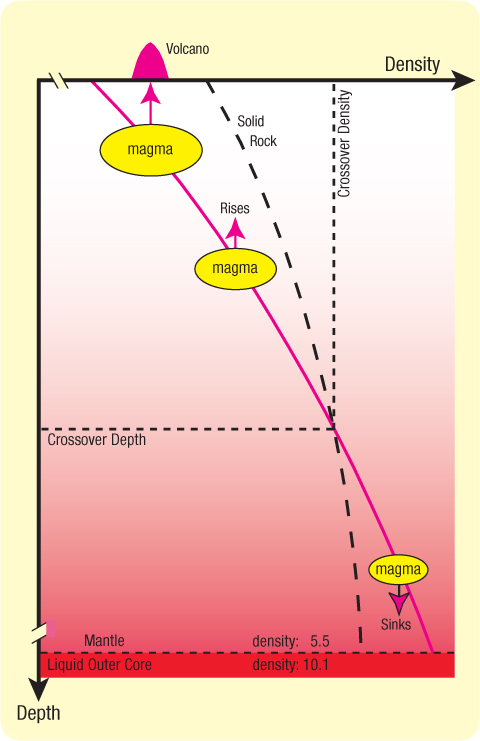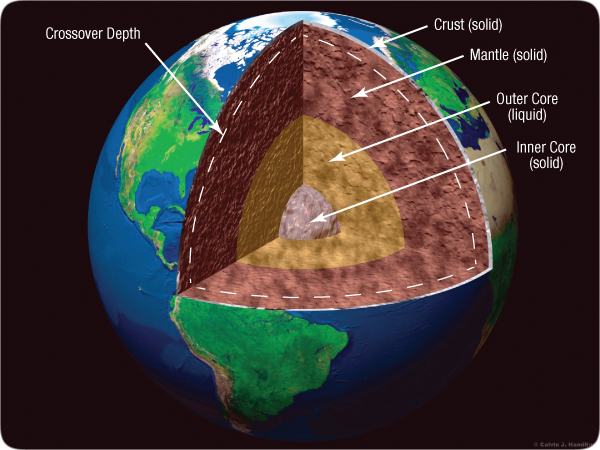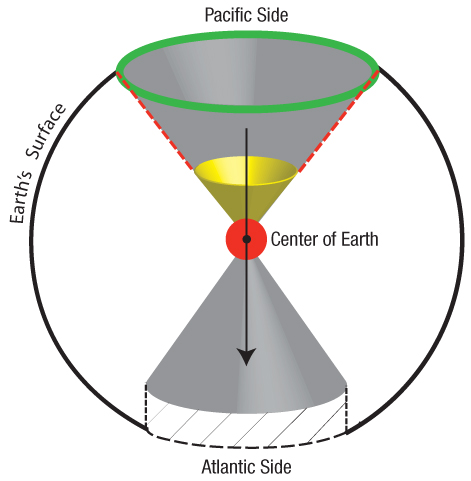Below is the online edition of In the Beginning: Compelling Evidence for Creation and the Flood,
by Dr. Walt Brown. Copyright © Center for Scientific Creation. All rights reserved.
Click here to order the hardbound 8th edition (2008) and other materials.
Theories Attempting to Explain Ocean Trenches, Earthquakes, and the Ring of Fire
Two broad theories try to explain ocean trenches, earthquakes, and the Ring of Fire: the hydroplate theory, and the plate tectonic theory. Each explanation will be given as its advocates would. Then, we will test these conflicting explanations against observations and the laws of physics.

Figure 85: Hydroplate Explanation for Trenches. (A) Before the flood, the weight of rock and water, pushing down on the subterranean chamber’s floor, balanced the floor’s upward pressure. The rupture destroyed that equilibrium. Directly below the rupture, the imbalance grew as escaping, high-velocity water and the 60-mile-high, unsupportable, crumbling walls widened the globe-encircling rupture hundreds of miles. Eventually, the imbalance overwhelmed the strength of the floor. First, the Mid-Atlantic Ridge buckled, or sprang, upward. As Europe, Africa, and Asia slid eastward and the Americas plate slid westward (based on today’s directions), weight was removed from the rising floor, causing it to rise faster, accelerating the hydroplates even more. Pressure directly under the floor, represented by the large black arrows, naturally decreased as the floor rose.
(B) During the flood phase, the escaping subterranean water eroded and thinned the preflood crust to a thickness of about 30 miles. Frictional heating from movements near the center of the earth began melting solid rock which then contracted, because of the extreme pressure and magma’s great compressibility, contracted, as explained in “Magma Production and Movement” on pages 159–160. This caused the crust on the Pacific side of the earth (the Pacific plate ) to subside by at least 30 miles, fracturing the Pacific plate at thousands of places within the boundaries of the Ring of Fire! 13 That drop steepened the downhill slope of the sliding hydroplates, allowing them to slide into the Pacific region without major obstructions. Downward buckling and deep faulting formed trenches. All this melting lubricated the shifts inside the earth and allowed gravitational settling, which released much more heat, increased earth’s spin rate, and converted the inner earth to today’s inner and outer core—monumental changes. The thick layer of magma expelled up onto the top of the sunken Pacific plate provided most of the heat that drove the ice age and accounts for the almost 40,000 volcanoes on the Pacific floor. Even today, magma sometimes breaks out and escapes upward, heating part of the ocean and creating “El Niño” weather conditions.14
The Hydroplate Theory. [For a summary of the hydroplate theory, see pages 113–150.] At the end of the flood phase, unsupportable, crumbling walls and erosion from escaping high-velocity water had widened the globe-encircling rupture to an average of about 1,400 miles. Exposed at the bottom of this wide, water-filled gap was the subterranean chamber floor, about 60 miles below the Earth’s surface. Before the rupture, the weight of rock and water pressing down on the chamber floor balanced the upward pressure directly under the floor. [See Figure 85.] Afterward, with the overlying rock suddenly gone, only the strength of the upward-bulging chamber floor and the weight of some water resisted this upward pressure. As the rupture widened, the Mid-Oceanic Ridge suddenly buckled upward.[See pages 130–133.]
The continental-drift phase began with hydroplates sliding “downhill” on a layer of water, away from the rising Mid-Atlantic Ridge. This removed more weight from the rising portion of the subterranean chamber floor, lifting it faster, and accelerating the hydroplates even more. As that part of the chamber floor rose to become the Atlantic floor, it stretched horizontally in all directions, just as a balloon stretches when its radius increases. This stretching produced cracks parallel and perpendicular to the Mid-Oceanic Ridge, forming the overlapping spreading centers shown on pages 115 and 145. Rising began in the Atlantic, so the Mid-Atlantic Ridge and its cracks are the most prominent of the oceanic ridge system.
The rising Atlantic floor pulled even deeper material upward. Within the inner Earth, material shifted toward the rising Atlantic floor, a broader, but initially shallow, depression formed on the opposite side of the Earth—the basins of the Pacific and Indian Oceans. Just as the Atlantic floor stretched horizontally as it rose, the western Pacific floor compressed horizontally as it subsided (sank).
The slope between the upward bulging Atlantic floor and the subsiding Pacific floor steadily increased. (Figure 50 on page 117 shows one small, but telling, “snapshot” of what followed.) The instability that triggered the continental-drift phase was like that of a large, flat rock resting in the center of a horizontal teeter-totter. Slight imbalances (such as variations in the width of the rupture during the flood phase and the shifting of water from the Atlantic side to the Pacific side) will slowly tip our teeter-totter. A tipping point will be reached where the rock will rapidly accelerate downhill, so the tipping will increase even more. Although the Earth departed significantly from a spherical shape, gravity restored most of that spherical shape in the following months and years.
In the western Pacific, near the center of the combined Pacific and Indian Oceans, lies the trench region. As explained on pages 159–160, material beneath the western Pacific subsided at least 30 miles,13 so the Pacific plate sheared and buckled downward in some places, forming trenches. The Atlantic Ocean (centered at 21.5°W longitude and 10°S latitude) is almost exactly opposite this trench region (centered at 159°E longitude and 10°N latitude). [See Figure 83 on page 154.]
A simple, classic experiment illustrates some aspects of this event.
A cup of water is poured into an empty 1-gallon can. The can is heated from below until steam flows out the opening in the top. The heat is turned off, and the cap is quickly screwed onto the top of the can, trapping hot steam in the metal can. As this steam cools, a partial vacuum forms inside the can. The can’s walls buckle inward, forming wrinkles in the metal—“miniature trenches.”
The upper 5 miles of the Earth’s crust is hard and brittle. Below the top 5 miles, the large confining pressure will deform rock if pressure imbalances are great enough.29 So, as the western Pacific floor sank, it sheared and buckled into “downward creases,” forming trenches. The hard crust and deformable mantle frequently produced trenches with an “arc and cusp” shape. The brittle crust cracked and slid in many places, especially along paths called Benioff zones.30

Figure 88: Trench Cross Section Based on Hydroplate Theory. Notice that the trench axis will generally not be a straight line. Sediments (green) hide the top of a fault plane that would otherwise rise a few hundred feet above the floor. Other sediments (not shown) and flood basalts (dark gray) cover most of the western Pacific floor. The three large black arrows show the direction of the rising Atlantic and the forces that downwarped the mantle and the Pacific plate. Earthquakes occur on the many faults produced, especially in Benioff zones and at low tides. Most volcanoes are not above Benioff zones, but are near a myriad of other faults near the center of the western Pacific, where there was considerable downwarping and shearing.
High-pressure deformations inside the Earth produced faulting and, therefore, extreme friction—and heat.
To appreciate the heat generated, slide a brick one foot along a sidewalk. The brick and sidewalk will warm slightly. Sliding a brick an inch but with a mile of rock squarely on top would melt part of the brick and sidewalk. Earth’s radius is almost 4,000 miles. Place a few thousand of those miles of rock on top of the brick and slide it only one thousandth of an inch. The heat generated would melt the entire brick and much of the sidewalk below.
Small movements deep inside the solid Earth, even microscopic, puttylike deformations, melted huge volumes of minerals. This released the water locked within the crystalline structure of certain minerals.

Figure 89: Earthquake Depths. Each earthquake begins at a point called the focus, somewhere below the earth’s surface. Wouldn’t you expect that most foci occur at a certain depth, or that they increase or decrease with depth. Surprise! For earthquakes with a magnitude of 5.0 or more, there are two peaks. In other words, earthquake foci are bimodal with depth.40
The fact that there are two peaks—one 22 miles (35 kilometers) below the earth’s surface and the other at 370 miles (600 kilometers) below—tells us that two types of earthquakes occur, each at a different depth. The hydroplate theory explains both conditions and why conventional geophysics does not explain the root cause of earthquakes.
Shallow earthquakes (above depths of 220 miles) involve only brittle fracture and sliding friction.41 However, cracks or space should not open up to allow movement for deep earthquakes where pressures are extreme. Geophysicists have tried for more than 80 years to explain why earthquakes occur at 220–410-mile depths .42 Those rocks should be so hot that they would not break, but would deform like hot tar—slowly and quietly.Those earthquakes occur where pressure and heat should cause rocks to deform and flow before enough stress can build up to cause failure. How then do deep earthquakes occur?
Here’s a clue based on the hydroplate theory. Few earthquakes occur at 220 mile depths—the crossover depth—because magma produced along faults at that depth has little tendency to rise or sink. Magma above 220 mile depths expands and tries to rise to the earth’s surface. Magma below 220 mile depths contracts and drains into the outer core. Figure 90 completes the answer.]

Figure 90: Strange Displacements during the 9.0 magnitude, 11 March 2011 Japanese Earthquake. The Japanese government, using the Global Positioning System (GPS), continuously measures the location of 1,200 points to an accuracy of better than an inch. Each arrow above shows the direction and distance that a point on the ground moved during that earthquake. Some points moved 18 feet (5.5 meters)! Horizontal movements appear to converge toward the epicenter, Point E. The actual earthquake began at the focus, 20 miles below Point E (below the earth’s surface), on the fault (the Benioff zone) that descends from the Japan Trench—down and to the west, under Japan.
How can rock suddenly converge radially toward a point? Obviously, rock near the focus, far below Point E, must have been removed to make room for the convergence—to allow the surrounding rock to collapse. As discussed on page 159, frictional heating along the fault first melts grain-sized minerals with the lowest melting temperatures, causing them to expand, because they were above the crossover depth. (Remember: Tiny movements at the extreme pressures deep in the earth produce great heat and melting.) Minerals with higher melting temperatures remain solid, maybe for centuries, thereby encasing and trapping the tiny droplets of melted rock. [See "Liquid Droplets Seen in Hot, Compressed Rock" on page 163.]
If frictional heat steadily “soaks” into the rock on both sides of a fault, magma droplets will increasingly form, so sooner or later, leakage will begin. Paths will open up for the expanding melt to escape upward buoyantly. The highly compressed solid “scaffolding” (surrounding the focus and composed of minerals with the highest melting temperatures) will become unstable and eventually collapse. Frictional heating will instantly become extreme, so all nearby minerals will suddenly melt. The result: a powerful earthquake.
Similar events occur below the crossover depth, except there the melted minerals “shrink” (become denser), and slowly drain along faults down into the outer core. This ongoing process releases gigantic amounts of heat throughout the mantle and core,46 and will eventually produce many powerful earthquakes. However, when that will happen is uncertain.47

PREDICTION 8: By 2020, satellites in low-earth orbits will predict the location of major earthquakes several days beforehand. They will do this by measuring electrical changes in the ionosphere that are produced by piezoelectric voltages building up in stressed rock around the focus of the coming earthquakes. If the focus is above the crossover depth, which is 220 miles below the earth’s surface, upward escaping magma may also produce detectable heat around the epicenter days beforehand.
Suppose the inner Earth initially had a more uniform mixture of minerals. Heating would first melt minerals with lower melting temperatures, which would allow denser grains to settle and lighter grains to rise, a process called gravitational settling. This would generate much more heat and produce more faulting, melting, and gravitational settling. After many such cycles, the Earth’s core would form with solid, denser minerals (containing iron and nickel) settling to form the inner core and the melt forming the liquid outer core. Shifting so much mass toward the center of the Earth and doubling the density of the rock melting below the crossover depth would increase Earth’s rotational speed, just as the skater in Figure 84 on page 156 spins faster as she draws her arms closer to her spin axis.
In the mid-1980s, seismologists noticed that seismic waves pass through the inner core about 4 seconds faster when traveling along the axis of the magnetic poles.31 Other tests showed that this was because crystals in the inner core have a preferred orientation.32 That direction is slowly changing by about 0.4° per year,33 so the inner core is spinning slightly faster than the rest of the Earth.34 It can do this because the liquid outer core allows slippage. "The Origin of Earth’s Powerful Magnetic Field" on page 180 explains how this alignment of crystals arose. Other evidence, explained in Endnote 23, supports these powerful movements inside the Earth. Today, the Earth spins 365.256 times each year, but there are historical reasons for concluding that a year once had 360 days.35 [For details, see "Melting the Inner Earth" on pages 620–623.]
Shrinking Earth. The liquid outer core has a volume of 4.1 × 1010 miles3 (1.7 × 1011 km3)—7.7 times the volume of our moon. The outer core’s density is almost twice that of the mantle rock from which it came. Therefore, before the core formed, the preflood Earth’s volume was almost 4.1 × 1010 miles3 greater, so the Earth’s radius was about 180 miles larger than today. The Earth shrank.
Undoubtedly, most of this shrinkage occurred during and soon after the flood, as the mantle lost about twice the volume that the dense core gained. Earthquakes still occur, so the Earth is still shrinking, because slight amounts of relatively low density mantle rock below the crossover depth are still becoming high density magma draining into the outer core.
Can this shrinkage be measured? Marginally. The best (and highly impressive) measurements in changes of the Earth’s radius were conducted in 2000 and 2005 by the International Earth Rotation and Reference Systems Service in Paris, France,43 using seventy stations around the world. Those measurements (based on Satellite Laser Ranging, Very Long Baseline Interferometry, and the Global Positioning System) showed a 0.2 inch (5 millimeters) shortening of Earth’s radius during those 5 years. However, more accurate techniques were used in 2005, so the shortening may be due to improved accuracy. Future measurements should clarify the amount of shrinkage.
Before plate tectonics became popular, some geologists said that many of the Earth’s surface features were a result of past shrinkage deep within the Earth.44 Among the many crustal features they felt this would explain were ocean trenches, tablemounts, and the dropping of the Pacific Basin as one huge block. Most of those geologists believed that a molten Earth shrunk as it cooled over millions of years. However, because they could not provide convincing details, their idea has fallen into disfavor. [The belief in a molten Earth can be easily rejected. See “Molten Earth” on page 30.] Nevertheless, the idea of millions of years has remained in most people’s imaginations.

PREDICTION 9: The mean radius of the Earth has shrunk about 180 miles since before the flood. Earth is still shrinking, but at a much slower rate.
While these geologists did see evidence of shrinkage, they were reasoning only from the effects they saw back to possible causes. Had they also arrived at a consistent picture by reasoning from cause to effect and not been satisfied until the forces, energy, and mechanisms were understood, they would have been on firmer ground.
What caused the shrinkage? The greatest movements (within the Earth) caused by the rising Atlantic floor would have been at the center of the Earth. [See "Forming the Core" on page 164.] Also, the center of the Earth, where pressures are greatest, would have produced the greatest melting and shrinkage. Even slight movements of one mineral grain relative to an adjacent grain at those extreme pressures will produce instant melting followed by about 50% shrinkage. [See "Magma Production and Movement" on page 159.]
As the Atlantic side of the inner Earth rose, the Pacific side of the inner Earth had to collapse onto the magma forming and shrinking near the center of the Earth. This runaway subsidence, melting, and shrinkage fractured and distorted much of the Pacific side of the Earth—especially the brittle Pacific crust. Because the Pacific crust would not have dropped as “one huge block” (as early geologists thought), its thousands of fragments, buried under and within the magma that rose to the surface, will be difficult to detect seismically. However, the largest block, greater in area than India, is now recognized as a 94% submerged continent called, Zealandia.48 Researchers are also detecting some granite under the floors of the Pacific and Indian Oceans.49
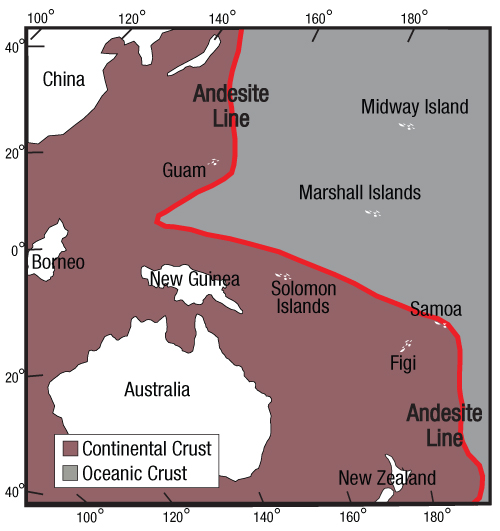
Figure 92: Andesite Line. This sharp discontinuity (shown in red) in the western Pacific was identified in 1912 by the famous New Zealand geologist, Patrick Marshall. The andesite line is considered “the most significant regional geologic distinction in the Pacific Ocean Basin,”95 although the term andesite line has fallen into disuse among plate-tectonic advocates.
Volcanic islands to the east of the andesite line are basaltic, while islands to the west are made of andesite, a type of rock named for its presence in the Andes Mountains. Andesite contains minerals, such as hornblende and biotite, that are not in basalt but are in granite (continental rock). Despite its significance, geologists have never explained why continental crust lies below the western Pacific.
Indeed, the presence of andesite, a fine-grained mixture of granite and basalt, west of the andesite line shows that at least fragments of continental rock (primarily granite) lie below the floor of the entire western Pacific. [See Figure 92.]
The types of rock found on [western Pacific] islands help to determine the edge of the Pacific Basin. The andesite line has on its ocean [eastern] side rocks composed primarily of basalt, whereas on the other [western] side they are principally andesite. This has been viewed as the dividing line between oceanic and continental crusts.” 50
For the most part, the andesite line also marks the true limit of the continents.51
Trenches formed and plates moved by the power of gravity. Gravity always tries to make the Earth more compact (or spherical).52 If you suddenly removed a bucket of water from a swimming pool (or even a 60-mile-thick layer of rock lying above what is now the Atlantic floor), gravity would tend to smooth out the irregularity. Because massive volumes of rock inside the Earth do not flow as fast as water in a swimming pool, mass deficiencies, which we might think of as slight partial vacuums, still exist under trenches. Today, especially at low tide (when the water’s pressure on the ocean floor is a minimum), mantle material slowly seeps in under trenches to reduce these “partial vacuums.” This stretches the crust above, produces extensional earthquakes near trenches, shifts plates toward trenches, and makes the Earth measurably rounder.53
Both the hydroplate theory and the plate tectonic theory are explained as their advocates would explain the theories. One should critically question every detail of both theories, and not accept either until all available evidence has been considered.
The Plate Tectonic Theory. Earth’s crust is broken into rigid plates, 30–60-miles thick, some with an area roughly the size of a continent. Some plates carry portions of oceans and continents. Plates move relative to each other over the Earth’s surface, an inch or so per year.
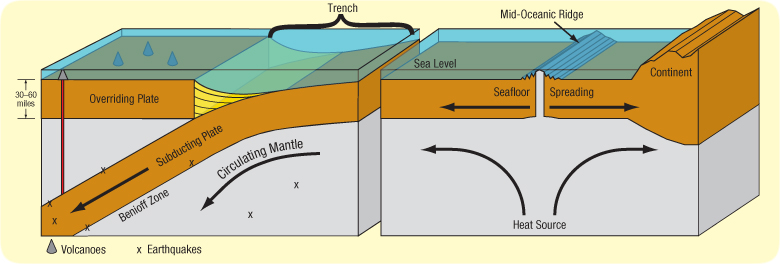
Figure 93: Plate Tectonic Explanation for Trenches. Internal heat circulates the mantle, causing large plates to drift over the earth’s surface. Consequently, material rises at oceanic ridges, forcing the seafloor to spread, so plates must subduct at ocean trenches, allowing layered sediments, shown in yellow, to collect. Earthquakes usually occur where plates subduct (Benioff zones) and at other plate boundaries. Subducting plates also melt rock, and the resulting magma rises to form volcanoes.
[Response: Actually, most volcanoes are not above Benioff zones. If this theory were correct, the yellow sediments would hide a cliff face that is at least 30 miles high and the trench axis should be a straight line. Also, some very large earthquakes occur far from plate boundaries. The powerful New Madrid, Missouri earthquakes of 1811 and 1812 and Charleston, South Carolina earthquake of 1886 are famous examples.]
Trenches formed and plates move by heat from radioactive decay. Just as hot water circulates in a pan on a stove, hot rock circulates slowly inside Earth’s mantle. Radioactive decay warms some parts of the mantle more than others. The warmer rock expands, becomes less dense (more buoyant), and slowly rises, as a cork rises when submerged in water. Sometimes, plumes of hot rock rising from the outer core break through the Earth’s crust as flood basalts. Conversely, relatively cold rock descends. Rising and descending rock inside the mantle forms circulation cells (convection cells) which drag plates forward. Currents within the mantle rise at oceanic ridges, create new crust, and produce seafloor spreading.
Because new crust forms at oceanic ridges, old crust must be consumed somewhere. This happens wherever two plates converge. The older plate is denser, because it had more time to cool. Therefore, it sinks below the younger plate and subducts into the mantle, forming a trench. A cold, sinking edge will pull down the rest of the plate and enhance circulation in the mantle. Earthquakes occur under trenches when subducting plates slip along Benioff zones and when plates slip past each other. At great depths, subducting plates melt, releasing magma, which migrates up to the Earth’s surface to form volcanoes. Most of the Ring of Fire is produced by subducting plates. Such slow processes require hundreds of millions of years to produce what we see today.
